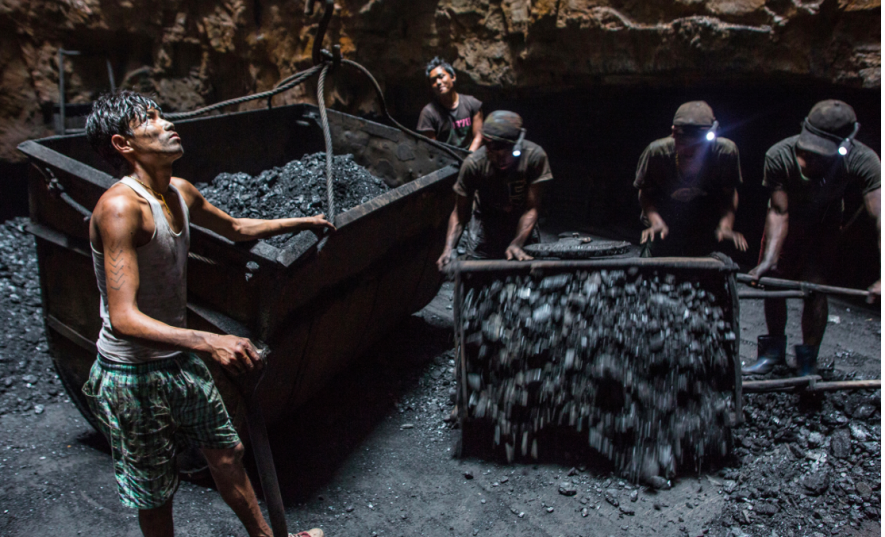Coal and the Future of India: Workers' Mahapadav

Image Courtesy: National Geographic
From 2000 to now, coal production in India has doubled but still falls short of domestic demand. To meet the shortfall, and to cater to growing consumption, the government has set a production target of 1.5 billion metric tons by 2020. It would seem that this booming sector would have satisfied and happy workers. But the reality is quite different - and scary.
“About 15 years ago there were over 6 lakh coal workers in India,” says Raghavan Raghunanadan, general secretary of the Coalfields Mazdoor Union. “Today that figure has been halved.” Raghunandan has been involved with union work for over 30 years and has been engaged with coal and steel as well as the unorganized sector (anganwadi and construction workers). The union operates in the Central Coalfields’ domain—from Ranchi in the north to Giridih in the south and Bermo to Daltonganj east to west. The way in which production is continually increased without hiring new employees is by outsourcing production (mining) work to private companies who, in turn, hire contract workers to get the job done.
“What this has resulted in, on the ground, is a very unnerving situation”, Raghunandan says. “Two people, working in the same area, say within half a kilometer of one another, are earning fantastically different wages.” A category 1 worker, the lowest rung on the employment ladder at public sector coal companies, now earns 26,000 rupees per month plus benefits. A contract worker, doing the same job, would make about 6,000. “There is despair and disquiet,” according to Raghunandan. “It is a tinderbox; a tragedy that, one day, the country will have to pay a price for”.
The coal unions have been successful—to an extent—in achieving union goals. Unlike many other sectors, organized coal workers receive a negotiated wage well above the minimum. This October the coal workers’ unions renegotiated wage scales with Coal India management. They also managed to fight off pressure to accept a 10-year wage agreement and will, instead, renegotiate in half that time. The steel unions, for example, did not have the bargaining chips to manage a similar victory. “Coal has always been at the forefront of this kind of thing,” Raghunanadan adds. A strike notice was sent to management in May 2017 and, by October, a new deal was in place. “It is not so much militant action. But we have always approached wage negotiations with a certain degree of aggressiveness”. At present, the government also wants to do away with social security measures such as provident fund and compassionate employment that are available to coal workers.
To counter the strength of the unions, the government has taken the most obvious of approaches—doing nothing. In the past 15 years, there has been virtually no new recruitment in the sector. Only statutory posts—such as that of the mining sardar—are filled. The other new hires are those who receive employment on compassionate grounds—dependents of coal workers who have died on the job. All young coal workers joining the industry today are contract workers. The government is simply waiting for the ageing workforce to peter out. So the coal company, which remains government owned, makes increasing profits. But those working in the mines earn progressively less (in real terms) money.
Coal is the second most hazardous industrial occupation in India, after ship breaking, in terms of fatalities in the line of duty. This is one of the reasons organized coal workers have been able to negotiate a decent wage for themselves. But one of the fundamental points of protest of the trade unions that have gathered in Delhi—irrespective of political affiliation—is the country’s steady march away from organized to contract labour. In varying degrees this applies to the service sector as well as industry. The lack of organization leaves workers in a position where they need to do more, without any questions, while earning well below what they need to afford a decent standard of living. This is the real tragedy of India’s growth economy model. “If you ask a man on the street what country he wants to migrate to, the chances are most will pick a developed nation,” says Raghunandan. “Based on individual preferences you might pick France, or Germany or even Singapore; All nations which guarantee a very high basic wage. This is because nations are judged by what the man on the lowest rung of the ladder earns. Can that man afford a decent standard of living? You cannot have a happy, fulfilled nation if you do not have a decent minimum wage. Without this, there is no point even thinking about the future”.
Get the latest reports & analysis with people's perspective on Protests, movements & deep analytical videos, discussions of the current affairs in your Telegram app. Subscribe to NewsClick's Telegram channel & get Real-Time updates on stories, as they get published on our website.
























